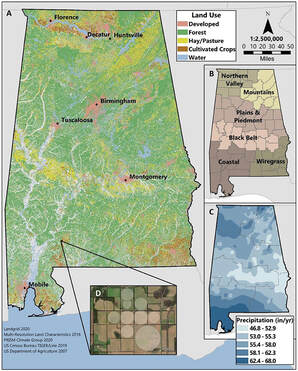 Rates of poverty and economic inequality in rural Alabama are among the nation's highest and increasing agricultural productivity can provide a needed boost to these communities. Despite the potential to enhance stability and resilience in rural economies, irrigated cropland accounts for only 5% of Alabama's total cropland as numerous barriers remain to irrigation adoption. Analysis of a new statewide, parcel-level dataset found that 68% of agricultural parcels in Alabama do not have riparian access to surface water and must rely on ponds or groundwater to support irrigation - both costly investments. Moreover, discrepancies in riparian access are amplified by socioeconomic and racial inequities throughout the state, but are particularly pronounced in the Black Belt region. This and deeper analyses of the status of irrigation in Alabama were recently published by Price et al. (2022) in Frontiers in Sustainable Food Systems. The analysis shows that of the 132,088 parcels in Alabama identified with at least 5 acres of cropland and/or pasture, only 42,089 (32%) have riparian access that could support irrigation. Parcels with riparian access are also on average much larger (109.8 acres) than those without riparian access (57.0 acres). Parcels without riparian access must also drill wells an average of about 20 feet deeper (261.8 ft) than those with riparian access (240.2 ft). While these discrepancies may seem dramatic at the state-level, differences in surface water access and barriers to irrigation adoption are concentration in areas with socially and historically disadvantaged farmers (SHDFs). A surprising finding of Price et al. (2022) was that parcels in the Black Belt lacking surface water or riparian access were more likely to be newly irrigated. There are two contextual factors that explain this outcome. First, large farms, which can achieve the economy of scale necessary to justify the investment in groundwater-based irrigation, are likely driving this irrigation trend. The Black Belt had the largest parcel sizes of irrigated parcels prior to the study period (by 2006) regardless of water access. Second, there are clear discrepancies among producers in the Black Belt that influence the probability of a transition to irrigation. According the USDA Agricultural Census statistics (USDA, 2020), the Black Belt has the highest proportion (0.37) of African American (2,114) to White (5,745) producers of any of the agricultural regions in the state. However, the Black Belt also has the largest inequity in average farm sizes between African American (85.31 ac; 34.52 ha) and White (308.31 ac; 124.77 ha) producers of any agricultural region in the state. Combined with limited return on irrigation investments for small farms, lack of access to credit and insufficient capital for initial investment have been noted as specific barriers to irrigation for African-American farmers in the Black Belt. Many farmers in this region are characterized as socially and historically disadvantaged farmers (SHDFs), for whom the capital required for accessing groundwater for irrigation is often prohibitive, which prevents them from building on other on-farm investments. Thus, it is mostly White, large-scale producers that are driving irrigation trends in the Black Belt. The unintended consequences of the state's riparian rights policy are particularly evident in this region where the discrepancies among producers are most pronounced and irrigation options are limited for producers without riparian or surface water access. Diverse policy tools are needed that acknowledge the varying motivations, constraints, and historical disadvantage faced by Alabama's farmers that have produced divergent agricultural systems in the state. |
AuthorAdvancing our knowledge of human-environment interactions through modeling and analysis. Archives
July 2022
Categories |
Equal Opportunity | UA Disclaimer | Site Disclaimer | Privacy | Copyright © 2018
The University of Alabama | Tuscaloosa, AL 35487 | (205) 348-6010
Website provided by the Faculty Resource Center, Office of Information Technology
The University of Alabama | Tuscaloosa, AL 35487 | (205) 348-6010
Website provided by the Faculty Resource Center, Office of Information Technology

 RSS Feed
RSS Feed
